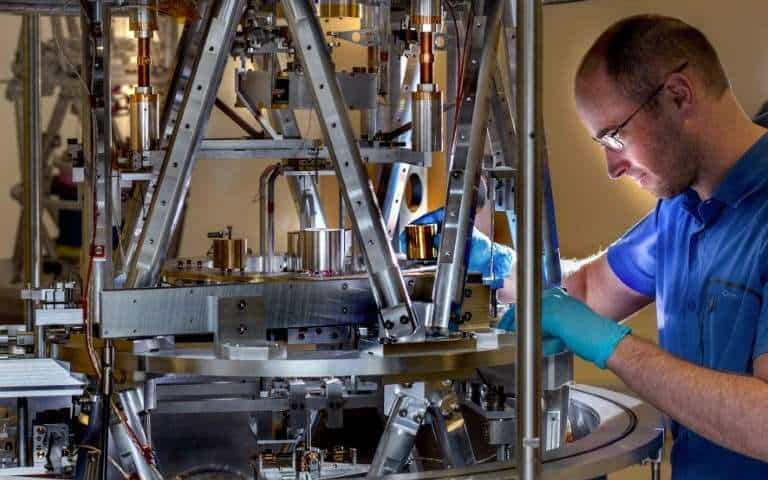
Sealed in a vault beneath a duke’s former pleasure palace among the sycamore-streaked forests west of Paris sits an object the size of an apple that determines the weight of the world.
Forged against a backdrop of scientific and political upheaval following the French Revolution, a single, small cylinder of platinum-iridium alloy has laid largely undisturbed for nearly 130 years as the world’s benchmark for what, precisely, is a kilogramme.
The international prototype of the kilogramme, or “Le Grand K” as it is tenderly known, is one of science’s most hallowed relics, an analogue against which all other weights are compared and a totem of the metric system that accompanied the epoch of liberty, equality and fraternity.
It’s so revered, in fact, that it’s only been weighed four times since 1889 and the room housing it in the Pavillion de Breteuil may only be opened when the three living key holders—who for security reasons must be of different nationalities—turn the lock simultaneously.
And yet it’s soon to be out of a job.
Hundreds of scientists from around the world will gather this week in the opulence of Versailles Palace for the 26th General Conference on Weights and Measures.
There, in an act belatedly fulfilling the metric system’s founding promise of “For all ages, for all people”, they will replace the Grand K with a universal formula that defines the kilogramme using the quantum laws of Nature.
“The kilogramme is the last unit of measurement based on a physical object,” said Thomas Grenon, director of France’s National Laboratory of Metrology and Testing.
“The problem is that it’s had a life, it could fluctuate. That’s not good enough, given the level of precision we need today.”
What’s in a second?
With the adoption of the metric system, scientists in the late 18th century needed to codify a single structure that expressed distance, time, electrical processes and mass in similar, transferrable, units of measurement.

The metre was used in turn to define mass: however much a cubed decimetre (10cm x 10cm x 10cm) of water weighed would henceforth be termed a kilogramme.
But science has moved on since the days of the revolution.
A metre is now defined by how far light travels in a vacuum during a fraction of a second.
The second itself used to be expressed relative to the rotation of the Earth. But since the 1960s, it has officially been the time it takes a caesium-133 atom to wobble 9,192,631,770 times—not a revolution less.
Instead of relating to the mass of a singular physical object, the kilogramme will in future be defined in terms of the Planck constant—the ratio of quantum energy a frequency of light can carry to that same frequency, or 6.626 x 10-34 joule seconds.
Energy is intrinsically linked to mass, as Einstein demonstrated with his equation E = mc2.
The Planck constant, combined with two quantum phenomena that allow for the creation of electrical power, can be used to calculate mass based on the equivalent mechanical power needed to displace it.
“If you push a mass, the power you need is dependent on that mass. And you can completely base that power on electrical power provided by our quantum constants,” Milton told AFP.
Proponents of this approach say it will be at least one million times more stable than physical artefacts and will have a range of practical applications in future.
“For a lot of applications, one kilogramme is a very big mass,” said Milton.
Advances in pharmaceutical and chemical production mean ingredients in medicines are increasingly measured to the microgramme, and are getting ever more precise.
“One kilo’s good for potatoes where you don’t need very much accuracy, but it’s not the right weight for many applications in demanding science and industry. The new system is infinitely scalable.”
‘States coming together’
Scientists will also use the Versailles summit to change how the ampere (electrical current), kelvin (temperature) and mole (atoms) are defined, all expressed through the universal laws of Nature.
Milton said the decision was a way of ensuring that the world would always agree on what, precisely, a kilogramme is—be it a bag of sugar, a litre of water or a precise quantum ratio.
“We are in a world where people are concerned that the drive towards multilateralism is halted and possibly reversing. But here, in measurement science, states really do come together to agree,” he said.
As for Le Grand K, it may have outlived its usefulness as the perfect kilogramme, but its contribution to science is far from over.
“It will stay here in the vault in the conditions it has been in since 1889,” said Milton.
“It’s actually a long-term experiment because we will weigh it in the decades to come to see how it reacts to the conditions. It continues to be an object of interest to science.”
